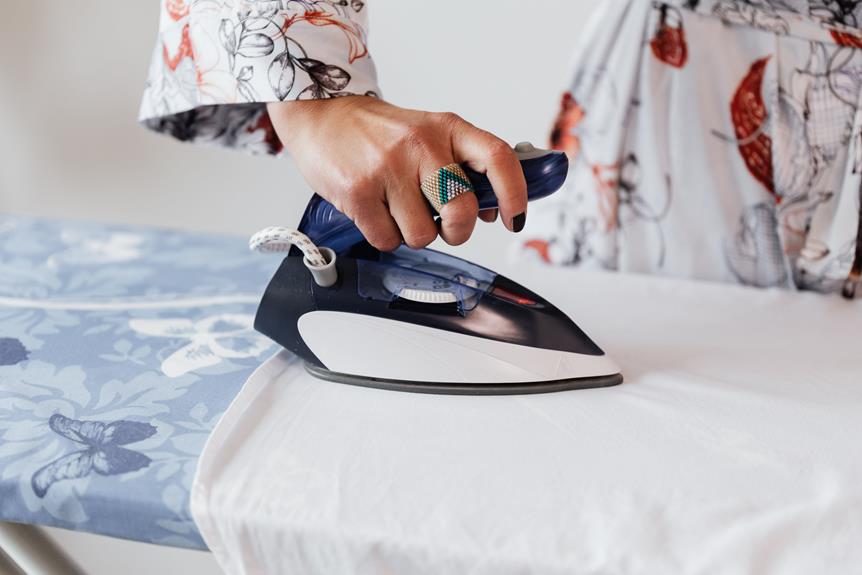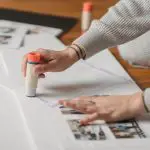Curious if Elmer's Glue can truly hold fabric together? You're not alone. This article delves into the nitty-gritty of using Elmer's Glue for fabric bonding.
From understanding its chemical makeup to testing its effectiveness on different fabric types, you'll gain a comprehensive understanding of this adhesive's potential.
By exploring tips for application and potential drawbacks, you'll be equipped to make an informed decision.
Additionally, we'll touch on alternative adhesive options for fabric to ensure you have a well-rounded view.
So, if you're ready to master the art of fabric adhesion, let's dive into the world of Elmer's Glue and its capabilities.
Key Takeaways
- Elmer's glue is primarily made of polyvinyl acetate, which forms a strong adhesive bond when it dries.
- Elmer's glue can be tested on different fabric types to assess its adhesive strength and durability.
- Tips for using Elmer's glue with fabric include applying a thin, even layer, allowing it to dry completely before handling, and using precise application tools for delicate fabrics.
- Potential drawbacks of using Elmer's glue on fabric include limited durability under repeated washing or exposure to moisture and the risk of the fabric becoming stiff or developing an undesirable texture.
Understanding Elmer's Glue Composition
How exactly does Elmer's glue hold fabric together?
Elmer's glue is known for its effectiveness in bonding various materials, including fabric.
The chemical composition of Elmer's glue plays a significant role in its fabric adhesion and bonding strength.
Elmer's glue is primarily made of polyvinyl acetate, a synthetic polymer that forms a strong adhesive bond when it dries.
When applied to fabric, the polyvinyl acetate in the glue penetrates the fibers and forms a durable bond as it cures.
This bonding strength allows Elmer's glue to effectively hold fabric together, making it a versatile option for various fabric-related projects.
Additionally, Elmer's glue is water-soluble when wet, making it easy to work with and allowing for easy clean-up.
Understanding the chemical composition of Elmer's glue provides insight into its adhesive properties and how it achieves strong fabric adhesion.
Whether for crafting, sewing, or repairs, Elmer's glue offers a reliable solution for bonding fabric with confidence in its effectiveness.
Testing Elmer's Glue on Various Fabric Types
You can test Elmer's glue on various fabric types to determine its adhesive strength and suitability for different materials. When conducting these tests, consider the following:
- Fabric Strength: Test Elmer's glue on different fabric types such as cotton, polyester, and denim to assess how well it adheres to these materials. This will give you insights into the bond's effectiveness on various fabric strengths.
- Bonding Durability: After applying Elmer's glue to the fabrics, subject them to stress tests such as stretching, washing, and exposure to various temperatures. This will help evaluate how durable the bond is over time and under different conditions.
- Comparison Across Fabrics: Compare the adhesive strength of Elmer's glue across the different fabric types. This will enable you to identify any patterns or variations in bonding effectiveness based on the specific fabric characteristics.
Testing Elmer's glue on various fabric types allows for a comprehensive assessment of its adhesive capabilities. By examining fabric strength and bonding durability, you can determine the most suitable applications for this adhesive based on the specific fabric types involved.
Tips for Using Elmer's Glue With Fabric
To effectively use Elmer's glue with fabric, start by applying a thin, even layer to the fabric's edges. This ensures that the glue spreads evenly and prevents the fabric from becoming stiff or misshapen.
When using fabric glue for crafting, it's important to allow the glue to dry completely before handling the fabric to avoid any shifting or misalignment.
For creative fabric projects, glue techniques can be varied. Experiment with using a toothpick or small brush to apply the glue with precision, especially for intricate designs or delicate fabrics.
Additionally, always follow the manufacturer's instructions for the specific type of fabric glue being used to achieve the best results.
If you need to bond larger fabric surfaces, consider using fabric glue in conjunction with other sewing techniques for added strength and durability.
Remember to test the fabric glue on a small, inconspicuous area of the fabric before starting your project to ensure compatibility and desired results.
Potential Drawbacks of Using Elmer's Glue on Fabric
When relying on Elmer's glue for fabric bonding, potential drawbacks may arise, affecting the overall quality and durability of your project. It's important to consider these potential drawbacks before deciding to use Elmer's glue on fabric.
Here are some key points to keep in mind:
- Potential Damage: Elmer's glue may not hold up well under certain conditions, such as repeated washing or exposure to moisture. This can lead to the fabric coming apart and the bond weakening over time.
- Long-Term Durability: While Elmer's glue can create a strong initial bond, its long-term durability on fabric may be questionable. Over time, the glue may become brittle and break down, causing the fabric to lose its integrity.
- Stiffness and Texture: Depending on the type of fabric and the amount of glue used, there's a risk of the fabric becoming stiff or developing an undesirable texture, which can affect the overall look and feel of the project.
Considering these potential drawbacks is crucial in making an informed decision about using Elmer's glue on fabric, as it can impact the longevity and quality of your project.
Exploring Alternative Fabric Adhesive Options
After considering the potential drawbacks of using Elmer's glue on fabric, it's important to explore alternative fabric adhesive options that can provide greater durability and longevity for your projects.
When it comes to fabric bonding, there are several adhesive alternatives that can offer superior performance.
One popular option is fabric glue, specifically designed for adhering fabric to fabric or other materials. Fabric glue creates a strong, flexible bond that's machine washable and dry cleanable, making it a reliable choice for various fabric-based projects.
Another alternative is fusible web, which is activated by heat and binds fabrics together when ironed. This method is commonly used in quilting and appliqué projects.
Additionally, sewing adhesives, such as double-sided tape or adhesive sheets, provide temporary or permanent bonding for fabrics without the need for stitching. These options offer versatility and strength, catering to different project requirements.
When exploring adhesive alternatives for fabric bonding, it's essential to consider the specific needs of your project to ensure a successful and durable bond.
Frequently Asked Questions
Can Elmer's Glue Be Used to Mend Delicate Fabrics Like Silk or Chiffon?
Yes, Elmer's Glue can mend delicate fabrics like silk or chiffon. It's a great fabric bonding technique. Apply a thin layer, let it dry for 24 hours. Alternatively, fabric glue or fusible web can also be used.
Will Elmer's Glue Hold up in the Wash or Will It Wash Out Over Time?
Elmer's glue can hold fabric together, but its durability in the wash may vary. For a more washable option, consider fabric glue or fusible web. Test a small area before committing to a project.
Is It Safe to Use Elmer's Glue on Fabrics That Will Be in Contact With Skin, Such as Clothing or Accessories?
Yes, Elmer's glue is generally safe for skin contact as it's non-toxic. It can hold fabric together, but for skin safety, consider fabric adhesives like fabric glue or patches for DIY fabric repair.
Can Elmer's Glue Be Used to Create Strong, Long-Lasting Seams in Fabric Projects?
Yes, Elmer's Glue can bond fabric effectively, offering durability. However, for stronger and longer-lasting seams, alternative fabric adhesives like fabric glue or fusible webbing are recommended. When comparing options, consider the specific needs of your fabric projects.
Are There Any Special Considerations or Techniques for Using Elmer's Glue With Stretchy or Elastic Fabrics?
When using Elmer's glue on non-stretchy fabrics, ensure the fabric is clean and dry for a strong hold. For applique designs, use a thin layer of glue for precise placement and hold.
- Daily Use Products Made of PET Nonwoven Fabric - July 11, 2025
- What Ink Is Best for Printing on PP Woven and Nonwoven Bags? - July 11, 2025
- How to Draft a Glove Pattern for Nonwoven Fabrics - July 11, 2025







